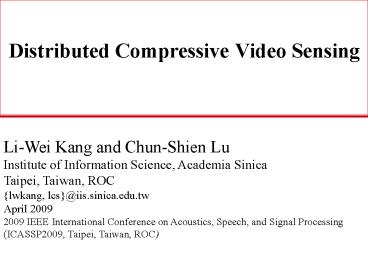Distributed Compressive Video Sensing
1 / 25
Title: Distributed Compressive Video Sensing
1
Distributed Compressive Video Sensing
2
Distributed Source Coding
Slepian and Wolf, 1973
3
Distributed Video Coding
Wyner-ZivIntraframe Encoder
Wyner-ZivInterframe Decoder
X
X
Girod, 2006
4
Distributed Video Coding
- The statistical dependency between X and Y
- Laplacian distribution
5
Compressive Sensing
- When data is sparse/compressible, one can
directly acquire a condensed representation with
no/little information loss - Random projection will work
Baraniuk, 2008
6
Compressive Sensing
- Directly acquire compressed data
- Replace samples by more general measurements
Baraniuk, 2008
7
Compressive Sensing
- y ?x ??? A?
x ??
y
?
?
?
M1
MN
N1
NN
A ??
Baraniuk, 2008
8
Measurement Matrix
- Scrambled block Hadamard ensemble (SBHE)
- partial block hadamard transform and random
column permutation - ? QMWPN
- L. Gan, T. T. Do, and T. D. Tran, Fast
compressive imaging using scrambled hadamard
ensemble, in Proc. of European Signal Processing
Conf., Lausanne, Switzerland, August 2008
(EUSIPCO2008).
9
Signal Reconstruction
- The convex unconstrained optimization problem
- Can be seen as a maximum a posteriori criterion
for estimating ? from - y A ? n,
- where n is white Gaussian noise
10
Signal Reconstruction
- Signal recovery from random measurements
- Gradient projection for sparse reconstruction
(GPSR) - Two-step iterative shrinkage/thresholding
algorithm (TwIST) - Orthogonal matching pursuit (OMP)
- M. A. T. Figueiredo, R. D. Nowak, and S. J.
Wright, Gradient projection for sparse
reconstruction application to compressed sensing
and other inverse problems, IEEE J. of Selected
Topics in Signal Processing, vol. 1,no. 4, pp.
586-597, Dec. 2007. - J. M. Bioucas-Dias and M. A. T. Figueiredo,
A new TwIST two-step iterative
shrinkage/thresholding algorithms for image
restoration, IEEE Trans. on Image Processing,
vol. 16, no. 12, pp. 2992-3004, Dec. 2007. - T. Blumensath and M. E. Davies, Gradient
pursuits, IEEE Trans. on Signal Processing, vol.
56, June 2008.
11
Distributed Compressive Video Sensing
- Measurement matrix ? scrambled block Hadamard
ensemble (SBHE) - Sparse basis matrix ? DWT
- Video signal sensing (encoder) general random
projection - Video signal recovery (decoder)
- Key frame GPSR with default settings
- CS frame
- side information generation (motion compensated
interpolation) - GPSR with the proposed initialization and the
proposed termination criteria
12
Distributed Compressive Video Sensing
Compressive video sensing
Video signal recovery
13
Distributed Compressive Video Sensing
- At the decoder, for a CS frame xt ??t
- its side information St ??St can be generated
from its previous reconstructed key frames - Proposed initialization
- initial solution at the 0-th iteration
- a(xt, St) the Laplacian parameter of (xt- St)
14
Side information generation
yt-1 Fxt-1 with higher MR
GPSR reconstruction
Reconstructed frame (t-1)
Key frame (t - 1)
Proposed Modified GPSR reconstruction
yt Fxt with lower MR
Non-key frame t
Side information (t)
Reconstructed frame (t)
yt1 Fxt1 with higher MR
GPSR reconstruction
Key frame (t 1)
Reconstructed frame (t1)
15
Distributed Compressive Video Sensing
a(xt, )
a( , St)
xt
St
a(xt, St)
16
Proposed Termination Criterion
- First
- Second
- Third
17
Proposed Termination Criterion
- MR is low (MR 20) if the First criterion with
Ta 0.9 is satisfied, the algorithm will stop - MR is middle (20 lt MR 70) if the First
criterion with Ta 0.05 or the Second criterion
is satisfied, the algorithm will stop - MR is high (MR gt 70) if the Third criterion
with TF 0.001 is satisfied, the algorithm will
stop
18
Simulation Results
- Foreman and Coastguard CIF video sequences with
300 Y frames (352288 101376 samples for each Y
frame) and GOP size 3 (Key, Non-key, Non-key,
Key, ) - The three approaches for comparison (all with
default settings) - GPSR, TwIST, OMP
- For OMP, block size 3232 suggested by
- V. Stankovic, L. Stankovic, and S. Cheng,
Compressive video sampling, in Proc. of
European Signal Processing Conf., Lausanne,
Switzerland, August 2008 (EUSIPCO2008).
19
Simulation Results
20
Simulation Results
21
Simulation Results
The reconstruction complexities for the Foreman
sequence
22
Simulation Results
The PSNR performance at different reconstruction
complexities for the Foreman sequence
23
Simulation Results
(a) Side information
(b) Reconstructed frame
24
Simulation Results
The reconstructed Foreman sequences (352288 for
each frame) at measurement rate (MR) 0.3 using
(a) GPSR (gradient projection for sparse
reconstruction) (average PSNR 27.68 dB)
(average reconstruction time 15.14 seconds per
frame) and (b) our DCVS (average PSNR 29.48
dB) (average reconstruction time 3.68 seconds
per frame) (This example shows the 54-th frame).
25
Conclusions
- The proposed DCVS approach exploits the two
characteristics - distributed video coding (DVC)
- compressive sensing (CS)
- The proposed DCVS can outperform or be comparable
with the three existing approaches for
comparison, especially at lower measurement rates - The proposed DCVS can significant outperform the
three existing approaches at the same
reconstruction complexity































